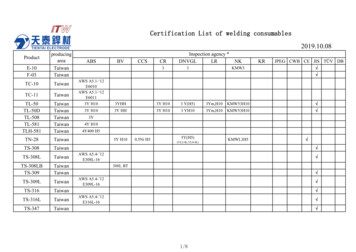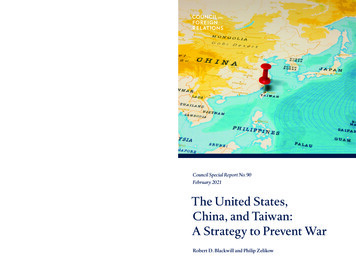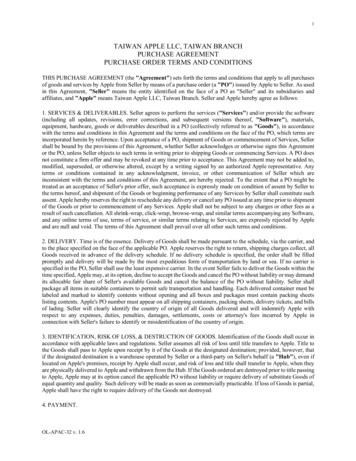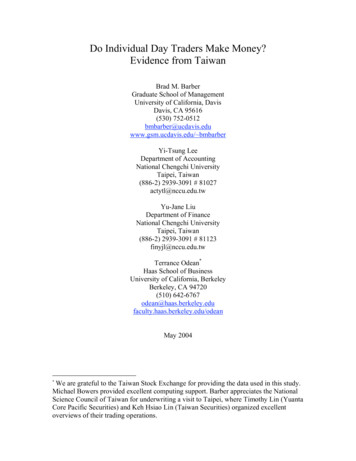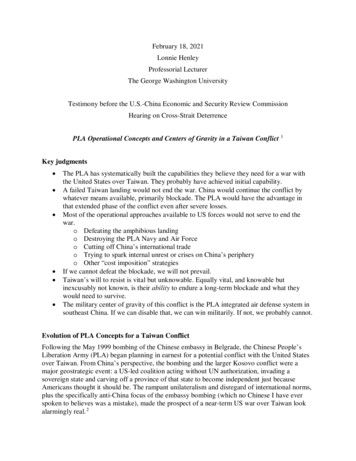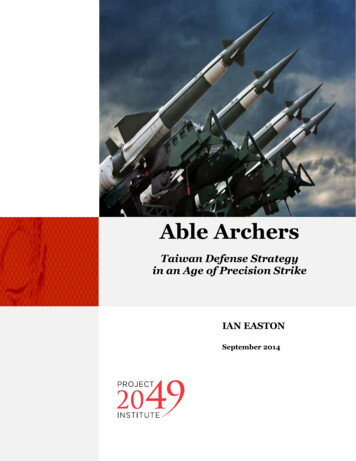
Transcription
Able Archers(Image Source: Wired.co.uk)Taiwan Defense Strategyin an Age of Precision StrikeIAN EASTONSeptember 2014
Able Archers: Taiwan Defense Strategy and Precision Strike Draft for CommentAble Archers: Taiwan Defense Strategyin an Age of Precision StrikeSeptember 2014About the Project 2049 InstituteCover Image Source: Wired.co.ukAbove Image: Chung Shyang UAV atTaiwan’s 2007 National Day ParadeAbove Image Source: WikimediaThe Project 2049 Institute seeks to guide decisionmakers toward a more secure Asia by the century’smid-point. Located in Arlington, Virginia, theorganization fills a gap in the public policy realmthrough forward-looking, region-specific researchon alternative security and policy solutions. Itsinterdisciplinary approach draws on rigorousanalysis of socioeconomic, governance, military,environmental, technological and political trends,and input from key players in the region, with aneye toward educating the public and informingpolicy debate.ii
Able Archers: Taiwan Defense Strategy and Precision Strike Draft for CommentAbout the AuthorIanEaston is a research fellow at the Project 2049 Institute, where he studies defense andsecurity issues in Asia. During the summer of 2013, he was a visiting fellow at the Japan Institutefor International Affairs (JIIA) in Tokyo. Previously, he worked as a China analyst at the Centerfor Naval Analyses (CNA). He lived in Taipei from 2005 to 2010. During his time in Taiwan heworked as a translator for Island Technologies Inc. and the Foundation for Asia-Pacific PeaceStudies. He also conducted research with the Asia Bureau Chief of Defense News. Ian holds anM.A. in China Studies from National Chengchi University in Taipei and a B.A. in InternationalStudies from the University of Illinois Urbana-Champaign. He studied Chinese at FudanUniversity in Shanghai, and National Taiwan Normal University in Taipei. He has testified beforethe U.S.-China Economic and Security Review Commission, and has lectured at the U.S. NavalWar College, Japan’s National Defense Academy, and Taiwan’s Political Warfare Academy.AcknowledgmentsAn earlier draft of this paper was presented at a conference hosted by Taiwan’s National DefenseUniversity on June 24, 2014. The author would like to acknowledge and thank NDU for its warmhospitality and excellent audience feedback. The author is indebted to individuals at the U.S.State Department in Washington, the American Institute in Taiwan, the U.S. Department ofDefense, the ROC Ministry of National Defense, and the ROC Ministry of Foreign Affairs for theirvaluable insights and assistance during the course of this research. Their contributions, whileunnamed, are many and much appreciated. Mr. Mark Stokes, USAF (ret.), Dr. Oriana SkylarMastro, Mr. Jason Bruzdzinski, Mr. Sam Mun, Ms. Sabrina Tsai, Mr. Craig Murray, Mr. KenAllen, USAF (ret.), and Dr. Bernard “Bud” Cole, USN (ret.) all deserve special thanks forreviewing various drafts of this paper and offering suggestions and recommendations that helpedto greatly improve its quality. The analysis and findings that follow are solely the responsibility ofthe author.iii
Able Archers: Taiwan Defense Strategy and Precision Strike Draft for CommentThis Page Intentionally Left Blankiv
Able Archers: Taiwan Defense Strategy and Precision Strike Draft for CommentTABLE OF CONTENTSExecutive Summary .viiIntroduction .1Chinese Precision Strike .3Ballistic Missiles .3Cruise Missiles and UAVs .5Rockets and Aircraft . .8Airbase Strike Capability .11Weapons Development .15Weapons Testing .19Taiwan Threat Assessments 21Taiwan Military Response .25Active Defenses .25Radars 26Intelligence .30Fighters .32SAM Systems .35Counterstrike .39Special Operations Forces . .45Passive Defenses .47Offshore Island Hardening .48Home Island Defense .49Airbase Hardening .50Airbase Resiliency 52v
Able Archers: Taiwan Defense Strategy and Precision Strike Draft for CommentContrasting Strategic Approaches .57Recommendations 61Operational .61U.S.-Taiwan Relations 63Three U.S. Policy Recommendations . 66Glossary of Terms .67vi
Able Archers: Taiwan Defense Strategy and Precision Strike Draft for CommentEXECUTIVE SUMMARYThe importance of Taiwan, due to its strategic position in the heart of East Asia and inthe Western Pacific, far exceeds the size of its territory and population. Moreover,Taiwan is a liberal democracy that plays a positive role in regional security. Yet China’scommunist party leadership views the Republic of China (ROC, or Taiwan) as anexistential political threat. Despite a recent warming in bilateral trade relations, Chinacontinues to rely on military coercion to resolve political differences with Taiwan, andthe long-term risk of conflict remains high. Going forward, much of Taiwan’s continuedindependence of action will hinge on its air strength.Contrary to reports, Taiwan has the capacity to deny air superiority to China, and it islikely to maintain this capability well into the future. This is of critical importancebecause airpower is often the single most decisive element of modern militaryoperations, and it is especially crucial for the defense of island nations like Taiwan. Bydenying China uncontested control over the air domain, Taiwan can raise the costs of amaritime blockade or amphibious invasion attempt to a prohibitive level. However, theair threat to Taiwan is growing rapidly.The Chinese People’s Liberation Army (PLA) firmly believes that it must suppressTaiwan’s air defenses to achieve its strategic objectives. A review of internal Chinesemilitary documents and technical studies reveals that the PLA would attempt surpriseattacks to neutralize Taiwan’s air force at the outset of conflict. A large-scale effort isunderway in China to build ballistic missiles and other weapons capabilities forcomplicating airbase operations in Taiwan. The implications of this armament programare serious, not only for Taiwan, but also for the United States and other regional airpowers.To counter this emerging challenge, Taiwan, assisted by the United States, isconstructing what may be the world’s most robust air and missile defense network. Thisincludes significant investments into early-warning radars, other intelligence,surveillance, and reconnaissance (ISR) assets, fighter upgrades, missile defense systems,and airbase hardening and resiliency. Taiwan’s objective is to maintain air parity withChina, not in terms of quantity, but through superior quality.Taiwan is developing unmanned aerial vehicles (UAVs) and strike systems able to effectsingle points of failure in the PLA’s theater-level operational system. These capabilitiesmay offset Taiwan’s geographic vulnerabilities, numerical, and other asymmetricdisadvantages. In addition, Taiwan plans to acquire next generation stealth fighters withshort take-off and landing capabilities, and submarines that can conduct anti-surface,anti-submarine, and ISR operations. But more can be done to communicate to the PLAthat the costs of potential cross-Strait aggression would far outweigh any hoped forbenefits.vii
Able Archers: Taiwan Defense Strategy and Precision Strike Draft for CommentTaiwan is leveraging its current advantages to undercut the coercive value of the PLA’sgrowing arsenal of increasingly accurate ballistic missiles. Beyond hard military issues,the United States has a significant role to play. Among a range of possible initiatives,Washington should grant consideration to: (1) increasing senior military officer visits toTaiwan, up to and beyond two star rank, with significant joint experience; (2) promotingworking groups for strategic and operational innovation, technical assistance, anddefense industrial cooperation; and (3) incorporating Taiwan into the rebalance to Asia,and U.S. strategy in the Asia-Pacific Region.The U.S. and ROC governments, working as partners with other allies who sharecommon interests, can successfully balance against the inherent risks and dangerssurrounding China’s emergence as a regional military power. However, as this studysuggests, the PLA is rapidly advancing its precision strike capabilities, and much hardwork will have to be done to stay ahead of it.viii
Able Archers: Taiwan Defense Strategy and Precision Strike Draft for CommentINTRODUCTIONThePeople’s Republic of China (PRC) is engaged in an ambitious militarymodernization program that has the potential to rapidly erode the defensive positions ofthe United States, Taiwan, Japan, and others in the Western Pacific. Among thestrategic drivers of the PRC’s military build-up, the most prominent is attaining theability to apply overwhelming force against the Republic of China (ROC, or Taiwan), andin a manner that could complicate foreign intervention. Along these lines, precisionstrike capabilities such as ballistic and cruise missiles, along with armed drones andguided rockets, are important strategic enablers. The Chinese People’s Liberation Army(PLA) views the development of these weapon systems as decisive for future airoperations against Taiwan. Given the centrality of airpower for modern warfare, Chinesewritings indicate a belief that the PLA must first control the skies above the TaiwanStrait before it can operate on the surface below.To achieve its strategic objectives, the PLA is striving for the ability to suppress Taiwan’sair defenses where they are at their weakest–on the ground. The PRC militaryarmament program is closely associated with a number of maturing precision strikecapabilities designed for attacking airbases. Referred to as “airfield runway blockades”by the PLA, such operations intend to overcome Taiwan’s air defenses through the useof missiles armed with penetrating warheads. The PLA hopes that once runway surfaceshave been sufficiently cratered, Taiwan’s highly capable air force pilots will be unable totake-off and wage war in the air. At that point, the PLA plans to take control of the skiesover Taiwan and execute follow-on bombing operations at significantly reduced cost andrisk.Maintaining the ability to deter and if necessary defeat any PLA attempt to establish airsuperiority over its sovereign territory is vital to Taiwan’s continued existence as a selfgoverning democratic state. By credibly threatening to deny the PLA access to itsairspace, the ROC can alter the PRC’s strategic calculus. The PLA is unlikely to mount amaritime blockade or amphibious invasion against Taiwan unless it can first achievecontrol over the air domain. Taipei’s ability to stop the PLA from gaining air superiorityreduces the possibility that Beijing may be tempted to resort to the use of force in afuture crisis. Moreover, by maintaining a strategy that includes asymmetric andinnovative defenses for slowing the PLA’s operational timelines, the ROC military canprovide U.S. government leaders with time to mobilize political, military, and economicsupport during a crisis or conflict.While air superiority alone does not ensure success in deterring war or winning amilitary campaign, it is often decisive in military operations. Furthermore, cross-Straitcrisis stability depends on eliminating any PRC incentives for “preemptive” first strikes.Improved air and missile defense is crucial to undermining potential PRC aggression. AsTaiwan evaluates future force postures during a period of fiscal austerity anduncertainty over U.S. security commitments, the Chinese defense establishment ismaking significant advances in developing a force capable of dominating the airenvironment around its periphery. In light of these trends, what is the PRC’s strategicthinking on Taiwan airbase vulnerability and how well positioned is it to exploit-1-
Able Archers: Taiwan Defense Strategy and Precision Strike Draft for Commentperceived weaknesses? What steps has Taiwan taken to improve its capacity towithstand surprise attack, recover, and generate sufficient combat power to achievedefense objectives in the face of continued enemy action? What more can be done?This paper provides an overview of the evolving airpower threat confronting Taiwan,and, by extension, the United States. This paper will begin by evaluating the PRC’sgrowing capacity for conducting precision strike operations against the ROC. Next, itwill explore Chinese military-technical writings to better understand the PLA’s plansand capabilities for attacking Taiwan. Then it will assess Taiwan’s militarymodernization program, and, in particular, its efforts to deny the PLA air superiority.This paper will conclude with a brief discussion on Taiwan’s future defense strategy andoffer recommendations for policymakers to consider as they work to maintain regionalpeace and stability.Figure 1: Map of Taiwan Strait Area (Source: Wikimedia and the Project 2049 Institute).-2-
Able Archers: Taiwan Defense Strategy and Precision Strike Draft for CommentCHINESE PRECISION STRIKEDriven by its long-standing mission to prepare for a conflict involving Taiwan, andlimited by a relatively backward air force, the PLA has been investing heavily inconventionally armed ballistic missiles as a means of acquiring an advantage across theTaiwan Strait. First deployed in the early 1990s, the PLA’s ballistic missiles lacked theability to reliably target military facilities on Taiwan, and instead were leveraged fortheir coercive effects as weapons of terror during the Third Taiwan Strait Crisis of 19951996. Technological advancements over the past decade, however, have allowed thePLA’s Second Artillery Force to greatly improve the tactical utility of its conventionalballistic missiles.Today the Second Artillery is able to hold almost all ROC military bases at risk with itsshort-range ballistic missile (SRBM) force. The Second Artillery is also increasinglycapable of using its medium-range ballistic missile (MRBM) force to threaten front-lineU.S. airbases in Japan and carrier groups in the Western Pacific. This situationundermines confidence in American commitments to aid in the defense of Taiwanshould conflict occur. Moreover, the Second Artillery is developing a conventionalintermediate-range ballistic missile (IRBM) for striking U.S. airbases on Guam and theNorthern Mariana Islands that would be critical in responding to Chinese aggressionagainst Taiwan.1Ballistic Missiles. The Second Artillery has deployed a large force of road-mobileSRBMs opposite Taiwan, and is continuing to improve its missiles in terms of bothquantity and quality. The National Air and Space Intelligence Center (NASIC) releasedan authoritative report in 2013 that stated the PLA has deployed six SRBM types,including the newly developed DONG FENG-16 (DF-16, or CSS-11).2 The PLA is alsodeveloping two new SRBMs along with maneuvering reentry vehicles and othercapabilities for greater penetration of targets in Taiwan. The Second Artillery wasreported to have fielded over 1,100 SRBMs across from Taiwan by late 2012, and itcontinues to deploy more advanced variants while replacing earlier generation missilesthat lack precision strike capabilities.3 Looking ahead, one recent report projected thePLA could have approximately 1,400 SRBMs targeting Taiwan by 2025. According tothe report, these would be primarily comprised of advanced DF-11 (CSS-7), DF-15 (CSS-Ballistic missile types are defined as follows: SRBMs have a range of under 1,000 kilometers (or 621miles); MRBMs have ranges from 1,000 to 3,000 kilometers or (621 to 1,864 miles); and IRBMs haveranges from 3,000 to 5,500 kilometers or (1,864 to 3,418 miles). Any ballistic missile with a range of over5,500 kilometers (3,418 miles) is defined as an intercontinental ballistic missile (ICBM). See Ballistic andCruise Missile Threat (Wright-Patterson AFB, OH: National Air and Space Intelligence Center, July 2013),p. 9, accessible online at http://www.afisr.af.mil/news/story.asp?id 123355694.2 Ibid., pp. 10-12.3 Military and Security Developments Involving the People’s Republic of China 2013 (Arlington, VA:Department of Defense, 2013), p. 42, accessible online athttp://www.defense.gov/pubs/2013 china report final.pdf.1-3-
Able Archers: Taiwan Defense Strategy and Precision Strike Draft for Comment6), and DF-16 (CSS-11) SRBM variants, and include special warheads for targetingTaiwan’s current ballistic missile defenses.4The Second Artillery’s SRBM infrastructure across from Taiwan is commanded by the52 Base, headquartered in Anhui Province’s Huangshan City.5 The 52 Base oversees atleast six SRBM brigades, and as many as three MRBM brigades in southeastern China.Two other brigades that could be involved in a Taiwan scenario appear to report directlyto the 53 Base in Kunming. The Second Artillery’s SRBM brigades each have a commandpost that oversees six launch battalions, a technical support battalion, acommunications battalion, an electronic countermeasures (ECM) group, and a railtransfer point. A dedicated regiment under the 52 Base headquarters appears to storemost SRBMs and their related assemblies and components at a hardened facility inShangrao County, Fujian Province, with annexes around Qimen and Leping.Second Artillery SRBM brigades arrayed against Taiwan have been identified as follows: Leping/Shangrao SRBM Brigade (96165 Unit). Located in Jiangxi Province,this unit is believed to be armed with DF-15 or possible DF-16 SRBM variants. Yong’an SRBM Brigade (96167 Unit). Located in Fujian, this unit is believedto be armed with DF-15 SRBM variants. Meizhou SRBM Brigade (96169 Unit). Located in Guangdong, this unit isbelieved to be armed with DF-11 SRBM variants. Ganzhou SRBM Brigade (96162 Unit). Located in Jiangxi, this unit is believedto be armed with DF-11 SRBM variants. Jinhua SRBM Brigade (96164 Unit). Located in Zhejiang, this unit is believedto be armed with DF-11 SRBM variants. Xianyou SRBM Brigade (96180 Unit - formerly under Nanjing MilitaryRegion). Located in Fujian Province, this unit was previously equipped withDF-11 SRBMs. Its current missile system is unknown. Puning SRBM Brigade (96212 Unit - formerly under Guangzhou MilitaryRegion). Located in Guangdong Province, this unit was previously equippedwith DF-11 SRBMs. Its current missile system is unknown.6While the SRBM launch battalions under each of the above SRBM brigades areequipped with road mobile missiles, identified launch units are generally located withinDefense Policy Advisory Committee, China’s Military Threats against Taiwan in 2025 (Taipei, Taiwan:New Frontier Foundation, March 2014), p. 73, accessible online athttp://www.dpp.org.tw/upload/news/20140304120411 link.pdf.5 The following section draws from Mark Stokes, “Expansion of China’s Ballistic Missile InfrastructureOpposite Taiwan,” AsiaEye Blog, April 18, 2011, at inas-ballistic-missile.html. See also Mark A. Stokes and Ian Easton, Evolving Aerospace Trends in theAsia-Pacific Region: Implications for Stability in the Taiwan Strait and Beyond (Arlington, VA: Project2049 Institute, May 2010), pp. 9-10.6 There are also two new ballistic missile brigades that have been identified by Mark Stokes in Shaoguanand Qingyuan, respectively. The former is armed with a new type of missile that has not yet beenidentified. The latter is believed to be armed with medium-range DF-21D ASBMs. See Mark Stokes,“Expansion of China’s Ballistic Missile Infrastructure Opposite Taiwan,” AsiaEye Blog, April 18, 2011, -chinas-ballistic-missile.html.4-4-
Able Archers: Taiwan Defense Strategy and Precision Strike Draft for Comment100 kilometers or less of their respective brigade command posts and rely heavily uponrailway lines for transport.7 In a conflict, it can be expected that they would deploy to alimited number of pre-surveyed launch sites.8 The Second Artillery’s training exercisesfrequently emphasize maneuver, camouflage, and other measures for decreasing thevulnerability of launch units.9 Each SRBM launcher has around seven to eight missilesassigned to it, and each time Second Artillery units launch a missile they move toanother location before firing again to enhance survivability.10Authoritative PLA documents, such as the Science of Military Strategy and the SecondArtillery Force Science of Campaigns, indicate that the principal mission of China’sSRBMs would be to strike Taiwan’s air defenses at the outset of a conflict. 11 Suchoperations would include SRBM attacks on Taiwan’s air defense command and controlcenters, early-warning radars, and airbases. Only once Taiwan’s air defense networkswere sufficiently degraded would the PLA commit its manned air combat forces tootherwise perilous bombing operations against Taiwan’s broader defense infrastructureand seek to establish air superiority.12 PLA writings suggest that surprise attacks withSRBMs at the outset of conflict would be conducted in coordination with land attackcruise missiles and unmanned aerial vehicles (UAVs).13Cruise Missiles and UAVs. To augment its ballistic missile forces, the PLA hasrecently begun investing in large numbers of land attack cruise missiles (LACMs) andarmed UAVs to saturate Taiwan’s air and missile defense systems. At both theoperational and strategic levels of warfare, China’s cruise missiles and drones haveserious implications for Taiwan’s security. Like the Second Artillery’s ballistic missilesystems, LACMs and UAVs are technologically challenging to defend against. However,unlike ballistic missiles which generally have fixed, predictable trajectories, cruisemissiles and drones are able to strike from any direction and fly at very low altitudes,making them difficult to detect and counter. Cruise missiles and UAVs are also moreaccurate and inexpensive to build than ballistic missiles and, because of their relativelysmall sizes, can be launched from a variety of platforms, further adding to theiroperational agility. 14 The Second Artillery appears to operate two brigades equippedSee Stokes and Easton, p. 11.Theoretically, road mobile launch units could use an unlimited number of ad hoc sites for conductingoperations. However, given the organizational culture of the PLA, with its strong emphasis on the strictadherence to pre-arranged plans, it can be expected that Second Artillery launch units would generallyoperate from prepared sites.9 Military and Security Developments Involving the People’s Republic of China 2013, p. 31.10 The author is indebted to Ken Allen for this point.11 See Peng Guangqian and Yao Youzhi (eds.), The Science of Military Strategy (Beijing: Military Science78Publishing House, 2005), p. 327; and Yu Jixun, ed., Second Artillery Force Science of Campaigns [第二炮兵战役学] (Beijing: Liberation Army Press: 2004), pp. 392-398.Yu Jixun, et al., pp. 392-398.Yu Jixun, p. 398.14 For a detailed overview of cruise missile capabilities and developments, see Dennis M. Gormley,Andrew S. Erickson, and Jingdong Yuan, A Low-Visibility Force Multiplier: Assessing China’s CruiseMissile Ambitions (Washington, D.C.: NDU Press, 2014). See also Dennis M. Gormley, Missile Contagion:Cruise Missile Proliferation and the Threat to International Security (Westport, CT: Praeger SecurityInternational, 2008); and Ian Easton, The Assassin Under the Radar: China’s DH-10 Cruise Missile1213-5-
Able Archers: Taiwan Defense Strategy and Precision Strike Draft for Commentwith CJ/DH-10 ground-launched cruise missiles (GLCMs). Subordinate to the 53 Baseand the 55 Base, respectively, these GLCM brigades are organized along similar lines astheir SRBM counterparts, with six launch battalions consisting of two companies each. 15Identified as rapid reaction units capable of cross-country deployment, these GLCMbrigades are capable of holding targets in Taiwan at risk from a distance of at least 1,500kilometers. 16 While unconfirmed, a tentative assessment suggests that they may bedeployed as follows: Liuzhou GLCM Brigade (96215 Unit). Located in Guangxi Province; subordinateto the 53 Base. Yichun GLCM Brigade (96317 Unit). Located in Jiangxi Province, subordinate tothe 55 Base.17In addition, the Second Artillery appears to operate a number of UAV units that wouldsupport precision strike operations in a Taiwan contingency. Second Artillery UAVscould provide direct targeting support for conventional ballistic and land attack cruisemissile operations. They could also engage in mass “kamikaze” attacks on radars andother important air defense sites. Second Artillery analysts view UAVs as criticalenablers for cueing, target acquisition, and battle damage assessment (BDA) missions insupport of ballistic and cruise missile operations. 18 While speculative, possible unitsunder direct command of the Second Artillery Headquarters in Beijing include: The 96605 Unit at Hui’an Air Base in Fujian Province; and The 96626 Unit in Dongyang City, Zhejiang Province.These units may be tasked with providing national-level intelligence to support strategicstrike operations against Taiwan. SRBM units that may be equipped with tactical UAVsinclude: The 52 Base’s 96180 Unit in Xianyou, Fujian Province (SRBM brigade formerlyunder Nanjing Military Region); and The 53 Base’s 96212 Unit in Puning, Guangdong Province (SRBM brigadeformerly under Guangzhou Military Region).19Program (Arlington, VA: Project 2049 Institute, October 2009), p. 4, athttp://project2049.net/documents/assassin under radar china cruise missile.pdf.15 It should be noted that the commander of a GLCM company is likely to be a captain or first Lieutenantwithout much experience. While unknown, it seems unlikely that they would have the authority to launch“their” missiles. The author is indebted to Ken Allen for this point.16 Stokes and Easton, pp. 14-15.17 Ibid.18 Ian M. Easton and L.C. Russell Hsiao, The Chinese People’s Liberation Army’s Unmanned AerialVehicle Project: Organizational Capacities and Operational Capabilities (Arlington, VA: Project 2049Institute, March 2013), pp. 11-12, accessible online athttp://project2049.net/documents/uav easton hsiao.pdf. Unless otherwise noted, the following sectionon UAVs draws from this report.19 Mark Stokes, “Expansion of China’s Ballistic Missile Infrastructure Opposite Taiwan,” AsiaEye Blog,April 18, 2011, at hinas-ballistic-missile.html.-6-
Able Archers: Taiwan Defense Strategy and Precision Strike Draft for CommentAside from Second Artillery units, the PLA Air Force (PLAAF) appears to have anunmanned combat aerial vehicle (UCAV) brigade in the Nanjing Military Region AirForce Headquarters in Fuzhou, with five subordinate groups in Fujian and Guangdong.At least two groups could be equipped with converted J-6 UCAVs. With up to 200aircraft believed to be in service, the PLAAF’s J-6 UCAVs are likely intended for use asdecoys to saturate and destroy Taiwan’s air defense systems and help create gaps forSecond Artillery missiles to exploit. These UCAVS could also be tasked with a variety of“high-risk” bombing and electronic warfare missions. The PLAAF has importedapproximately 100 HARPY drones from Israel for targeting Taiwan’s air defense radarswith small anti-radiation (radar seeking) warheads.Looking ahead, it appears that PLAAF may be developing UAVs that can fly informations, engage in aerial refueling, and take-off and land autonomously. PLAAFengineers have already begun to explore using manned aircraft to control multipleUCAVs. For example, one well-funded study in 2011 simulated the use of one mannedfighter aircraft to control three or more UCAVs for a land attack mission. 20 This appearsto be linked to a PLAAF ambition of developing UAVs for long-range bombingmissions.21The PLA ground forces across Taiwan are equipped with tactical reconnaissance UAVs.Candidate platforms include the heavier BZK-005 and BZK-009; the medium weightASN-105 and ASN-206; and the light ASN-104 and W-50.22 Elite amphibious divisionsunder the Taiwan-focused 1st Group Army and 42nd Group Army appear to be the first inChina to establish reconnaissance battalions with UAV-equipped companies. 23 PLAground force artillery units have been investing in UAVs for battlefield reconnaissancemissions. PLA writings describe reconnaissance UAVs as particularly well suited forsupporting over the horizon artillery and long-range rocket units.2420Liu Yuefeng and Zhang An, “Research on Multi-Agent Architecture for Coordinated Formation Air-to-Ground Attacks [编队协同对地攻击多 Agent 系统体系结构研究],” Xitong Fangzhen Xuebao (Journal ofSystem Simulation), February 2011, pp. 372-375. Note that this research was funded in part by the PRC’sAviation Science Grant [航空科学基金].21 Easton and Hsiao, p. 12.22 The Military Balance 2013 (London, UK: Institute for International and Strategic Studies, March 2013),p. 288-289.23 These are reportedly the Guangzhou MR’s 42nd Group Army’s 124th Amphibious Division, and theNanjing MR’s 1st Group Army’s 1st Amphibious Division. See “Merrily Discu
hospitality and excellent audience feedback. The author is indebted to individuals at the U.S. State Department in Washington, the American Institute in Taiwan, the U.S. Department of Defense, the ROC Ministry of National Defense, and the ROC Ministry of Foreign Affairs for their valuable insights and assistance during the course of this research.
